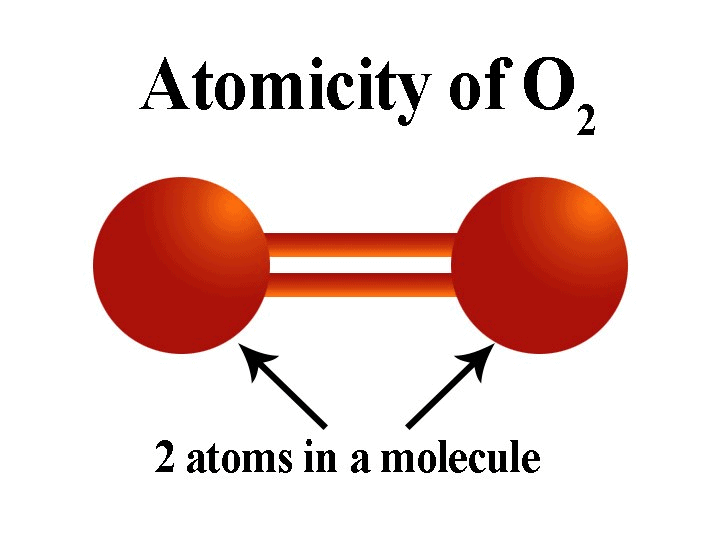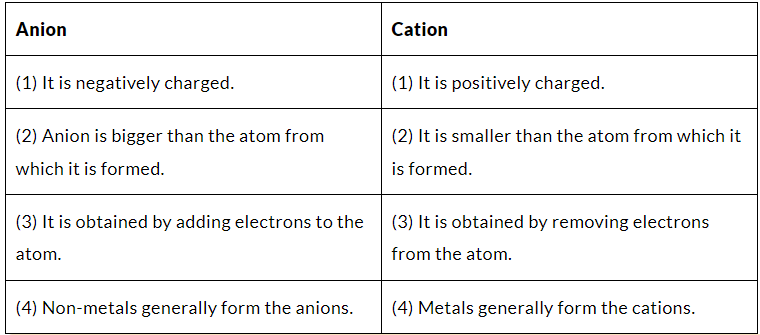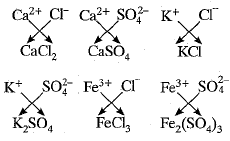Class 9 Science - Atoms and Molecules Previous Year Questions
Short Answer Type Questions
Q.1. (a) Write the chemical formula of magnesium chloride and sodium hydroxide.
(b) Calculate the molecular mass of nitric acid (HNO3). [H = 1 u, N = 14 u, O = 16 u] [2024]
Ans. 

(b) Molecular mass of nitric acid HNO3
= (1 x 1 u) + (1 x 14 u) + (3 x 16 u)
= 1 u + 14 u + 48 u
= 63 u
Q.2. Find which would weigh more 2 mole of CaCO3 or 10 mole of H2O. [2024]
Ans. 1 mole of CaC03 weighs = (1 x 40 g) + (1 x 12 g) + (3 x 16 g)
= 40 + 12 + 48 = 100 g
2 moles of CaCO3 weigh = 2 x 100 g = 200 g
1 mole of H2O weighs = (2 x 1 g) + (1 x 16 g)
= 2 g + 16 g = 18 g
10 moles of H2O weigh = 10 x 18 g = 180 g
Therefore, 2 mole of CaCO3 weigh more.
Q.3. (i) Write the chemical formula of sodium oxide.
(ii) Calculate formula unit mass of ZnO. [Zn = 65, O = 16]
(iii) Define ion. [2024]
Ans. (i) Na2O
(ii) Formula unit mass of ZnO = (65 u + 16 u) = 81 u
(iii) An atom or group of atoms carrying positive or negative charge is called an ion. For example, CI-, chloride ion.
Q.4. Find the number of moles in: [2024]
(i) 176 g carbon dioxide.
(ii) 12.044 x 1023 number of carbon dioxide molecules.
(iii) Oxygen atoms in 44 g of carbon dioxide. [Atomic mass: C = 12 u, O = 16 u]
Ans. (i) Molecular mass of CO2 = 12 + 32 = 44 u
44 g of CO2 = 1 mole
176 g of CO2 = 
(ii) 6.022 x 1023 molecules of CO2 = 1 mole
12.044 x 1023 molecules of CO2 
(iii) 44 g CO2 means 1 mole of CO2
= 12.044 x 1023 atoms of oxygen
Q.5. State any four postulates of Dalton’s atomic theory of matter. Which of his postulates does not hold correct at present? [2023]
Ans. The postulates of Dalton’s atomic theory of matter are:
(i) All matter is made of very tiny particles called an atom.
(ii) Atoms of a given element are identical in mass and chemical properties.
(iii) Atoms of different elements have different masses and chemical properties.
(iv) Atoms combine in the ratio of simple whole numbers to form compounds.
(v) Atoms are indivisible particles that cannot be created or destroyed in a chemical reaction.
The postulate that atoms are indivisible particles does not hold good at present. We know that an atom is made up of protons, neutrons and electrons.
Q.6. (a) Define atomicity.
(b) State the atomicity of the following molecules:
(i) Oxygen
(ii) Phosphorous
(iii) Sulphur
(iv) Argon [2023]
Ans. (a) The number of atoms in one molecule of the substance is called atomicity.
(b) Atomicity of the substances is given as under:

Q.7. What is Avogadro’s constant? [2022]
Ans. Avogadro’s constant is the number of particles (atoms, ions or molecules) present in one mole of the substance. Its value is 6.022 x 1023.
Q.8. The atomic number of three elements A, B and C are 9, 10 and 13 respectively. Which of them will form a cation? [2022]
Ans. The element with the atomic number 13 will form a cation. It has electronic configuration 2, 8, 3. It loses three electrons to attain a stable octet and forms the cation.
Q.9. Name the isotope of an element that is used in the treatment of cancer. [2021]
Ans. An isotope of cobalt is used in the treatment of cancer.
Q.10. The atomic mass of Calcium is 40 u. What will be the number of Calcium atoms in 0.4 u of Calcium? [2020]
Ans. 40 u of calcium contains 1 atom
0.4 u of calcium contains 1/40 x 0.4 = 10-2 atoms
Q.11. (i) Write the full form of IUPAC.
(ii) Hydrogen and oxygen combine in the ratio of 1: 8 by mass to form water. What mass of oxygen gas would be required to react completely with 3 g of hydrogen gas? [2020]
Ans. (i) International Union of Pure and Applied Chemistry
(ii) 1 g of H2 combines with 8 g of oxygen. 3 g of H2 combines with 8 x 3 = 24 g of oxygen.
Q.12. Name the international organisation which approves the name given to the elements. [2019]
Ans. IUPAC, the International Union of Pure and Applied Chemistry.
Q.13. As per the law of definite proportions carbon and oxygen combine in a ratio of 3:8. Compute the mass of oxygen gas that would be required to react completely with 6 g carbon. [2018]
Ans. 3 g of carbon combines with 8 g of oxygen
∴ 6 g of carbon will combine with = 8/3 x 6 =16 g of oxygen.
Q.14. (a) Which among the following has more number of molecules:
1 g of hydrogen (H2) or 1 g of methane (CH4)?
(Atomic mass of H = 1 u, C = 12 u)
(b) Calculate the number of particles in 46 g of Na atoms.
(Atomic mass of Na = 23 u) [2018]
Ans. (a) 1 g of H2 contains number of molecules
= 1/2 x 6.022 x 1023
= 3.011 x 1023 molecules
1 g of CH4 contains number of molecules
= 1/16 x 6.022 x 1023
∴ 1 g of H2 contains more number of molecules.
(b) The atomic mass of Na atom = 23 g
∵ 23 g Na atom contains 6.022 x 1023 particles
∴ 46 g Na atom will contain
Q.15. The oxide of aluminium has a chemical formula AI2O3. State the valency of AL. [2018]
Ans. The valency of AI = 3.
Q.16. State three points of difference between anion and cation. [2018]
Ans.
 Q.17. What is AMU? Which quantity is measured in terms of AMU? [2017]
Q.17. What is AMU? Which quantity is measured in terms of AMU? [2017]
Ans. AMU stands for Atomic Mass Unit.
Atomic mass is measured in terms of AMU.
Q.18. Who gave the laws of chemical combination? [2017]
Ans. Lavoisier and Proust
Q.19. What do you understand by an octet of electrons in the valence shell? [2017]
Ans. If there are eight electrons in the outermost shell of an atom, we say that it has an octet of electrons. All atoms have a tendency to acquire octet of electrons in the valence shell.
Q.20. (a) Define one mole. How is it related to Avogadro’s constant?
(b) Find the number of sodium ion in one mole of sodium sulphate. [2016]
Ans. (a) 1 mole is defined as equal to 6.022 x 1023 particles. It is also equal to molar mass in grams.
1 mole = Avogadro’s constant
= 6.022 x 1023
(b) 1 mole of Na2SO4 contains 2 moles of Na+
2 moles of Na+ = 2 x 6.022 x 1023
= 12.044 x 1023 = 1.2044 x 1024Na+ ions.
Q.21. Define atomicity. Give an example of each of monoatomic, diatomic, tetra-atomic and polyatomic molecules. [2016]
Ans. Atomicity is defined as the number of atoms present in a molecule. He is monoatomic, H2 is diatomic, P4 is tetra-atomic and S8 is polyatomic molecules.
Long Answer Type Questions
Q.1. (a) What is meant by molecular formula? State with example what information can be derived from a molecular formula?
(b) Write the names of the compounds represented by the following formulae:
(i) Mg(NO3)2
(ii) K2SO4
(iii) Ca3N2 [2022]
Ans. (a) Molecular formula of a compound shows the constituent elements and the number of atoms of each element present in one molecule of the compound.
Take the example of H2SO4. It is the molecular formula of sulphuric acid. It shows that
(i) Sulphuric acid molecule is constituted of hydrogen, sulphur and oxygen.
(ii) One molecule of sulphuric acid contains two atoms of hydrogen, one atom of sulphur and four atoms of oxygen.
Q.2. (i) Write chemical formulae of all the compounds that can be formed by the combination of the following ions:
(b) The molar mass of nitrogen is 14u. What will be the mass of one atom of nitrogen in grams? [2021]
Ans. (a)
(b) 1 mole of nitro g en atoms = 14 g
1 mole of nitrogen atoms
= 6.022 x 1023 atom
6.022 x 1023 atoms of nitrogen weigh = 14 g
1 atom of nitrogen weighs
Q.3. (a) Calculate the number of oxygen atoms in 0.10 mole of Na2CO3.10H2O.
(b) If one mole of sulphur weighs 32 grams, what is the mass (in grams) of 1 atom of sulphur?
(c) Identify the correct formula for ammonium sulphate from the following formula: [2019]
[2019]
Ans. (a) 1 mole of Na2CO3.10H2O contains 13 x 6.022 x 1023 atoms of oxygen
∴ 0.10 moles of Na2CO3.10H2O will contain= 0.10 x 13 x 6.022 x 1023
= 7.83 x 1023 oxygen atoms.
(b) 1 mole of sulphur = 32 g
Also 1 mole of sulphur
= 6.022 x 1023 atoms
Now, 6.022 x 1023 atoms of sulphur weigh = 32g
∴ 1 atom of sulphur weighs
(c) (NH4)2SO4
|
84 videos|543 docs|60 tests
|
FAQs on Class 9 Science - Atoms and Molecules Previous Year Questions
| 1. What are atoms and how do they relate to molecules? |  |
| 2. What is the law of conservation of mass in relation to chemical reactions? |  |
| 3. How do you calculate the molecular mass of a compound? |  |
| 4. What is the difference between a compound and a mixture? |  |
| 5. What are the different types of chemical bonds? |  |






















